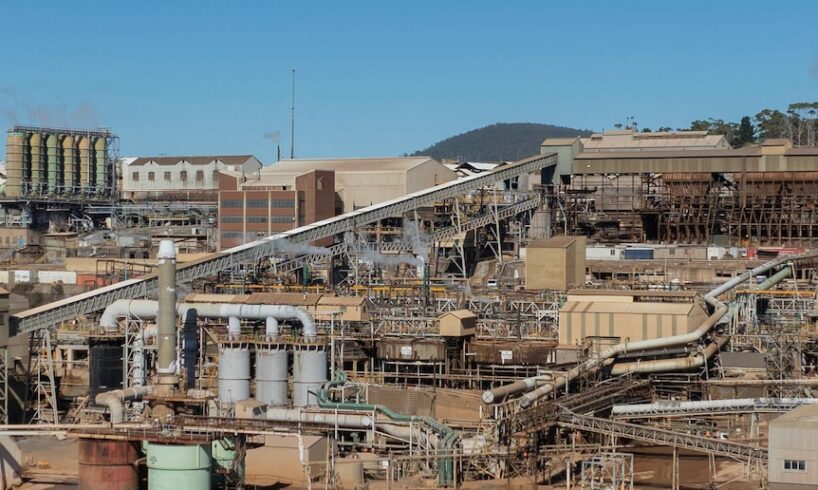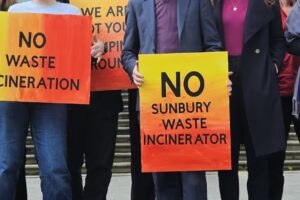
Tasmania’s Environment Protection Authority (EPA) has announced it will carry out extensive monitoring of lead dust deposit rates in residential areas near two major industrial facilities.
The monitoring will include 45 sites covering the Hobart suburb of Lutana and the city’s eastern shore, related to the Nyrstar zinc smelter, starting later this month.
It will also monitor lead dust in the town of Rosebery, near the MMG mine, starting later this year.
The sites are the largest industrial emitters of lead to air in Tasmania.
Numerous locations on the River Derwent near to the Nystar smelter will be tested for lead dust deposits. (ABC News: Magie Khameneh)
The last studies were in 2009 and focused on lead in soil, including health monitoring of children.
The 2009 studies found no risk to human health.
EPA chief executive Catherine Murdoch said the decision to carry out “the most spatially extensive monitoring program” for the area was not due to non-compliance by Nyrstar or MMG.
She said it was instead due to the time since the 2009 studies.
“It is timely to ensure that we are applying contemporary methods for environmental and human health risk assessments,” Ms Murdoch said.
Catherine Murdoch said both MMG and Nyrstar continue to be compliant with emission regulations. (ABC News: Maren Preuss)
“The monitoring program will determine the current nature, extent and magnitude of lead and dust that is being deposited, enabling any human health risk assessments to be reassessed if required.”
Nyrstar and MMG already report lead emission levels to the national regulator, but the study is intended to determine lead deposit rates in surrounding areas.
Nyrstar to get $135 million of support
The EPA also recently completed studies of lead dust from a recycling facility in the Launceston suburb of Rocherlea, which showed lead was migrating off the site.
It then carried out sampling near Nyrstar earlier this year which determined lead remained in the area, before a broader testing program was developed in consultation with the state’s health department.
Public Health director Mark Veitch said the sites have been chosen due to the geography of the area, and the prevailing winds.
“Basically to ask the question: Does lead that may be being deposited in these environments pose any risk to human health?” Dr Veitch said.
The last studies of the area were in 2009. (ABC News: Luke Bowden)
“We don’t wish to create alarm in the populations immediately near or further away from these sites that they’re at imminent risk.
“There have been no signals over the past 15 years to suggest there has been an abnormal number of people [with elevated blood lead levels].”
The EPA confirmed that all results will be publicly released.
Tasmanian emissions comparably lower than mainland
Having marginally elevated blood lead levels is a notifiable disease, meaning the Department of Health must be notified.
Raising kids in a town where lead is everywhere
Each year the Department receives reports of about eight people with the condition.
The Nyrstar site emits about 620 kilograms of lead to air per year, while the MMG Rosebery site emits about 330 kilograms.
Dr Veitch said these amounts were considerably lower than areas of concern on the mainland, with emissions at Mount Isa, Queensland at about 150,000 kilograms per year, and at 23,000 kilograms per year in Broken Hill, New South Wales.
He said the studies would improve understanding of lead deposit rates, and could guide further studies and monitoring programs if required.
Mining company MMG has been operating in Rosebery for more than 85 years. (Supplied: MMG)
Testing in 1980s resulting in health advice
Nyrstar has been the subject of lead studies covering more than three decades.
Concerns about dust emissions were raised in the 1980s, resulting in a 1992 soil and vegetable sampling program.
This showed elevated lead, cadmium and zinc levels in soil, with vegetables — such as leafy greens — having cadmium levels above Australian food safety standards.
The Nyrstar site emits about 620 kilograms of lead to air per year. (ABC News: David Robertson)
Twenty-six children from the nearby area were tested in 1997, finding blood lead levels similar to the national average.
Further soil sampling was carried out in 2008, but results were similar to previous testing.
The EPA provided advice to gardeners to have leafy greens in raised beds rather than directly in the soil, and that lettuce, spinach, carrots, endives, cress and beets had the highest cadmium uptake.
Dr Mark Veitch said the announcement was not intended to “create alarm”. (ABC News: Maren Preuss)
It concluded that broader health impacts were not occurring.
“The uptake of lead and cadmium in residents in the area has been shown to be similar to control areas and national averages,” the 2009 report reads.
More information around lead exposure is available from the Department of Health website: www.health.tas.gov.au/lead





